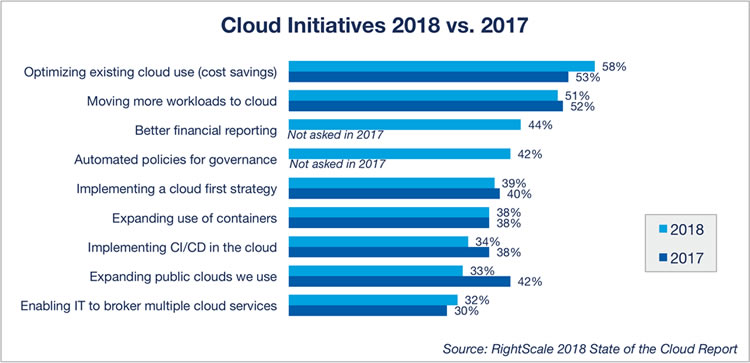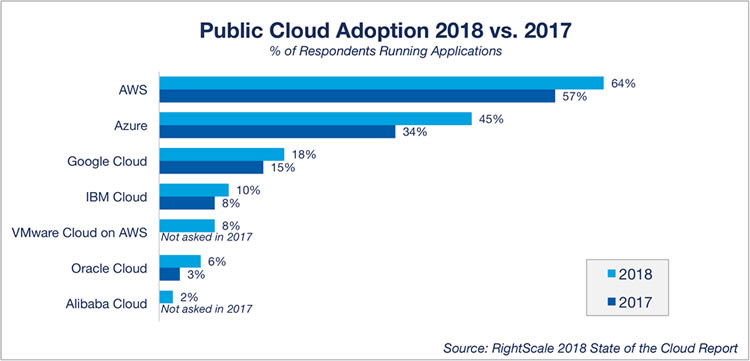Surprising Cloud Adoption Trends
We all know that businesses are moving to the cloud. But how? Anyone who knows the basics of cloud technology is also aware that there are many approaches to the adoption of cloud technology. An enterprise can choose from public, private, or hybrid solutions. They can go with only one cloud provider or they can develop a multi-cloud approach. Knowing how businesses are using the cloud will benefit any company that offers services to them. This article is for those curious readers who just have to know more.
The State of the Cloud in 2018
So how can we determine the nature of cloud adoption? The cloud management company RightScale has taken the guesswork out of it for us. In their survey published in January 2018, State of the Cloud Report, RightScale deals with the questions that many in the industry are asking. What percentage of businesses are actually using the cloud now? What’s really on the minds of those who make decisions about cloud adoption? How many cloud providers are companies using, and which ones? What kinds of services are they running on the cloud?
The study identifies industry trends and compares the 2018 results with those of 2017. RightScale surveyed 997 IT professionals, asking them a variety of questions about their experiences with cloud adoption and other technologies. More than half of the respondents were in organizations of 1,000 or more people. They call the study “the largest survey on the use of cloud infrastructure that is focused on cloud buyers and users, as opposed to cloud vendors”.
Some Surprising Results
You knew that many companies have started using more than one cloud provider. But that’s not the whole story. RightScale found that organizations are currently leveraging nearly 5 different clouds as part of their multicloud strategy. According to the study, “On average, survey respondents are using 4.8 clouds across both public and private. Respondents are already running applications in 3.1 clouds and experimenting with 1.7 more.”

And here’s another interesting factoid. The adoption rate for both public and private clouds is higher than you might have thought. The combined usage adds up to a towering 96% of respondents. So it’s not an exaggeration to say that everybody’s using the cloud today — with the exception of a meager 4% of non-adopters. More users are on the public rather than private cloud, but the popular choice is mixing a bit of both. Hybrid cloud users amount to 71% of respondents.

And here’s some news for you. Servers are on their way out. Well, in the way that we have traditionally understood them anyway. Serverless computing, a method of hosting applications that NetworkWorld calls “the next generation of cloud infrastructure,” is really taking off. RightScale lists it as #1 among the top growing cloud services, growing far faster than container, database, and disaster recovery solutions.

A Matter of Priorities
Spreading out resources among multiple cloud providers is important to today’s cloud users. That may have to do with not putting all your eggs in one basket. But cost is really the biggest thing on their minds:
“With significant wasted cloud spend, organizations are focusing on gaining control of costs. Optimizing cloud costs is the top initiative for the second year in a row, increasing from 53 percent of respondents in 2017 to 58 percent in 2018.”
Respondents told RightScale that they were concerned that they were somehow wasting 30% of their money. But they were wrong. RightScale estimates that as much as 35% of cloud spend is wasted. Here’s a summary of users’ concerns with a comparison between 2018 and 2017:

You would think that with all this concern about cloud cost, companies would try to automate as much as they can. But no. RightScale reported that the bulk of cloud management policies involve manual processes. Only 21% of inactive storage is eliminated through an automatic process, for instance, leaving that task for human intervention. That may be good for keeping techs employed, but it does nothing for cloud cost optimization.
Another aspect of this expanding cloud-first strategy has to do with how it is managed. Organizations have shifted their emphasis to the use of centralized controls. Most respondents have already established central cloud teams, and others are planning to do so. This development of centralized cloud governance is especially a priority for larger enterprises.

Containers, Tools, and Providers
Another area that is seeing significant growth is the use of containers, something Docker calls “a standardized unit of software”. Adoption of Docker containers has increased 40% from 2017, and the use of Kubernetes is now up to 27%. Use of Google Container Engine, though still at only 14% adoption, increased by a whopping 75% over last year — so it’s on the rise.
Configuration management tools are used by DevOps techs to deploy and configure servers and applications. Among them are Ansible, Chef, and Puppet, with Ansible showing a 71% growth increase over 2017.
It should be noted here that the adoption of the public cloud involves a competitive race, with lots of up-and-comers. AWS continues to retain a significant lead, but other providers are growing fast. Azure appears to be right on their heels.

Conclusion
We’ve covered the highlights of RightScale’s report here, but you may want to glean some more information from the original. We’ve told you before about the growth of hybrid cloud computing, and that trend is evident in this report. And we have made the case for load balancing in the cloud. What is clear is that — with a 96% adoption rate — the cloud is here to stay. The particulars of how it is used may continue to shift as people become more familiar with it. But we cannot leave you without a reminder about our favorite subject: uptime. In all the rush to adopt these new-fangled technologies or provide services along with them, we must not forget that keeping them running smoothly is of utmost importance. And that’s where Total Uptime comes in. You may find our article on 4 Cloud Gotchas to Avoid worth reading next!
 What is an Application Delivery Network?
What is an Application Delivery Network?  Global Server Load Balancing (GSLB)
Global Server Load Balancing (GSLB)  Measuring Failure
Measuring Failure 


